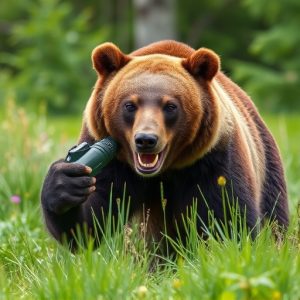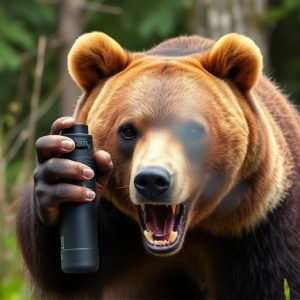Maximizing Protection: Alaska Bear Repellent Range and Ingredient Insights
Bear spray, a last-resort deterrent against bears, releases chemical agents like capsaicin into the…….
Bear spray, a last-resort deterrent against bears, releases chemical agents like capsaicin into the air to irritate and disorient bears. Its effectiveness depends on ingredients and storage, with expiration dates typically ranging from one to three years. High-quality products containing capsaicin or oleoresin capsicum offer maximum potency, but real-world factors can impact spray reach. Proper testing, knowledge of expiration dates, and choosing quality ingredients like capsaicin or canola oil are crucial for safe and effective bear repellents in Alaska's wilderness.
Alaska’s rugged wilderness attracts adventurers, but it also harbors bears. Understanding bear repellent maximum range is crucial for safety. This comprehensive guide delves into the science behind bear spray, its effectiveness, and key ingredients in maximum-range repellents. We explore expiration dates, performance at long distances, and essential considerations for Alaskans choosing the right protective gear. By understanding what’s inside your can, you can make informed decisions to navigate Alaska’s beautiful yet unpredictable landscapes safely.
- Understanding Bear Spray: An Overview of Its Purpose and Effectiveness
- Expiry Date and Shelf Life: What You Need to Know About Bear Spray
- Unlocking the Science: Key Ingredients in Maximum Range Bear Repellents
- Performance and Range: Can Bear Spray Protect You at Long Distances?
- Choosing the Right Bear Repellent: A Comprehensive Guide for Alaskans
Understanding Bear Spray: An Overview of Its Purpose and Effectiveness
Bear spray, also known as bear repellent, is a valuable tool for individuals venturing into bear country. Its primary purpose is to deter and scare away bears when faced with an encounter, providing a momentary escape route. This spray is designed to be used as a last resort when a person finds themselves in close proximity to a bear and cannot retreat safely.
The effectiveness of bear spray lies in its ability to create a barrier between the individual and the bear by releasing a powerful stream of odorless or slightly scented chemical agents into the air. These agents, often containing capsaicin (a component found in chili peppers), can cause irritation to a bear’s eyes, nose, and respiratory system, temporarily disorienting it. However, it’s crucial to remember that bear spray is not 100% guaranteed and should be used as part of a broader bear safety strategy, including making noise while hiking and staying aware of your surroundings. Additionally, understanding the expiration date and checking the ingredients are essential steps before using any bear repellent, ensuring its potency and effectiveness when needed.
Expiry Date and Shelf Life: What You Need to Know About Bear Spray
Bear spray, like any other product, has an expiry date and a shelf life that should be considered by users. Understanding these factors is crucial when it comes to ensuring the effectiveness of your bear repellent. Most high-quality bear sprays are designed with stability in mind, allowing them to remain potent for several years if stored properly. However, the active ingredients in bear spray can degrade over time, which may affect its performance.
The expiry date typically indicates when the product’s potency and quality have diminished to a level that it may not be as effective. This is often marked by the manufacturer as a ‘use by’ or ‘expiration’ date. After this date, the spray might still be safe to use but could offer reduced protection against bears. It’s recommended to check the ingredients list and understand what components contribute to the spray’s effectiveness. Some key ingredients to look out for include capsaicin, piperine, and other spicy compounds that deter bears through sensory irritation.
Unlocking the Science: Key Ingredients in Maximum Range Bear Repellents
The science behind maximum range bear repellents lies in their unique formulations, designed to deter even the most curious bears. Key ingredients play a pivotal role in their effectiveness and longevity. One of the primary components is capsaicin, derived from chili peppers. This ingredient creates a burning sensation when encountered by bear noses, prompting them to avoid the area. The formula’s stability and potency are crucial factors; therefore, manufacturers carefully consider the quality and source of capsaicin to ensure its consistency.
Additionally, synthetic or natural oils, such as those found in plants like mint or eucalyptus, are often included. These compounds possess aromatic properties that bears find unpleasant, further extending the repellent’s range. The interplay of these ingredients not only increases the product’s effectiveness but also determines its shelf life and expiration date. Understanding the ‘ingredients’ is essential for consumers to make informed choices, especially when considering factors like ‘does bear spray expire?’
Performance and Range: Can Bear Spray Protect You at Long Distances?
Bear spray, also known as bear repellent, is a popular choice for outdoor enthusiasts navigating Alaska’s rugged terrain. One of the primary concerns when considering bear protection is its performance and range. Can this powerful tool truly safeguard you from unpredictable wildlife encounters at long distances? It’s essential to understand that bear spray is designed to create a protective barrier by releasing a strong scent that bears find unpleasant, temporarily distracting them. The effective range varies based on several factors, including the quality of the product, weather conditions, and the specific ingredients used.
High-quality bear sprays are formulated with active ingredients like capsaicin or oleoresin capsicum, derived from chili peppers. These ingredients ensure maximum potency and can remain effective even in harsh environments. Manufacturers often provide specifications for the spray’s range, but it’s crucial to remember that these are ideal scenarios. In reality, factors like wind direction, distance, and the bear’s behavior can significantly impact the spray’s reach. Testing the spray beforehand and understanding its expiration date, which is typically several years if stored properly, will ensure you’re prepared for any potential encounters during your outdoor adventures in Alaska.
Choosing the Right Bear Repellent: A Comprehensive Guide for Alaskans
Choosing the right bear repellent is a crucial step for Alaskans navigating the state’s diverse wilderness. When selecting a bear repellent, several key factors come into play. Firstly, understand that not all repellents are created equal. Quality products are designed with effective ingredients that can deter bears from approaching. Common active ingredients include capsaicin, a compound found in chili peppers, and canola oil, which has shown promise in repelling grizzly bears.
Additionally, consider the expiration date and check for any signs of damage or deterioration, especially when it comes to bear spray. Unlike some consumer products, bear repellent does have an expiry, typically ranging from one to three years. The ‘ingredients’ section on the packaging is also vital; look for repellents that contain a high concentration of active ingredients, ensuring maximum effectiveness during your outdoor adventures in Alaska’s breathtaking landscapes.
When selecting a bear repellent for Alaska’s unique challenges, understanding the science behind ingredients, their effectiveness, and shelf life is key. While no repellant offers 100% protection at any range, choosing the right product with proven active ingredients can significantly reduce risk. Remember, proper usage and knowledge of expiration dates are essential for maximum protection during your outdoor adventures in Alaska’s vast wilderness.


